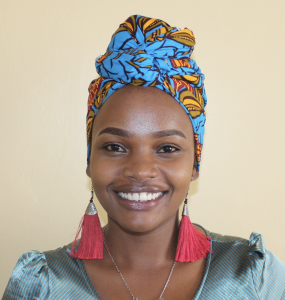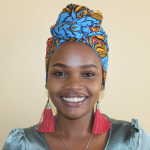May, 2021: Gimarakwa Primary School Project Complete!
Gimarakwa Primary School in Kenya now has access to a new source of safe, clean water thanks to the completion of their rain tank, which can collect 75,000 liters of water! We installed new latrines and handwashing stations for students, and we trained the school on improved sanitation and hygiene practices, including COVID-19 prevention. These components work together to unlock the opportunity for these students to live better, healthier lives.

A student holds a glass of clean water from the new rain tank.
"From today, I will trust the water that I drink. Back then, l had been diagnosed with typhoid on two occasions, which has always led me to abscond school to allow me to seek medical attention. With this water point in school, I see myself excelling in my examinations as I will have ample time for my class studies," said student Prudence, the elected Chair of the new student health club we formed during training.

Prudence poses at the rain tank.
Teachers were just as excited as the students about the new rain tank on campus.
"I now foresee a reduction in cases of water-related infections due to the availability of clean water directly in the school compound. For a long time, students used to abscond school when they weren't able to get water to carry to school. Installation of this water point will ensure a constant water supply in school," said Head Teacher Abunyu.
"With sufficient water in school, we anticipate general improvement in our academics due to an ample environment for learning."

Head Teacher Abunyu holds a glass of water from the rain tank.
How We Go From Ground to Rain Tank
Construction for this 75,000-liter rain tank was successful!
Parents, staff, and students helped our artisans gather everything needed for construction. The school’s kitchen staff and a few parents helped provide meals for the artisans, while the school provided the artisans’ accommodations. Local women and men helped our artisans with their manual labor, too.

Students deliver water to help with construction.
The process officially began with our staff and school administration looking around the school compound to determine the best location for a new rain tank. This needed to be the best site with enough land and a nearby building with good, clean roofing to catch the rainwater.

Students toss stones to add to the rain tank's foundation.
Then, we cleared the site by excavating the soil to make level ground for the tank foundation. We cast the foundation by laying big stones on the level ground and reinforcing them using steel wire, concrete, and waterproof cement. We affixed both the drawing pipe and the drainage pipe as we laid the foundation.

Pouring the foundation
Next, we formed the walls using a skeleton of rebar and wire mesh with sugar sacks temporarily tied to the outside as backing. We attached this to the foundation’s edges so that the work team could start the Ferro-cementing process. They began layering the walls with cement, alternating with the inner and outer side until six cement layers were in place. (The sugar sacks are removed once the interior receives its first two layers of cement.)

Affixing the tap and drainage pipes to the foundation
Inside the tank, we cast one central and four support pillars to ensure the dome does not cave in once cemented. Meanwhile, we plastered the inner wall while roughcasting the outer walls.

Interior cement work
We dug and plastered the access area to the tap outside the tank, installing a short staircase. In front of the access area, we constructed a soak pit where spilled water can drain from the access area through the ground. The pit helps to keep the tap area dry and tidy.

Drawing point work
Dome construction could begin after the tank walls settled. We attached a dome skeleton of rebar, wire mesh, and sugar sacks to the tank walls before cementing and plastering it using similar techniques as the wall construction. We included a small manhole cover into the dome to allow access for future cleanings and water treatments.

Working on the pillars
We propped long wooden poles (about 75 of them!) inside the tank to support the dome while it cured. Then it was down to the finishing touches: fitting a lockable cover over the tap area, affixing the gutters to the roof and tank, and setting an overflow pipe in place at the edge of the dome for when the tank reaches capacity.

Dome work
Once finished, we gave the rain tank three to four weeks to undergo complete curing. Finally, we removed the interior support poles and dome sugar sacks and cleaned the tank.
We officially handed over the rain tank to the school directly following the training. Students and staff celebrated the presence of clean water on campus. The event was an excellent chance for us to acknowledge the school administration and students as the primary parties entrusted with the tools we have given and remind them of our continued support as they develop. Happiness, thanksgiving, and appreciation were the order of the day flowing in all directions.

VIP Latrines
This project funded the installation of six new ventilated improved pit (VIP) latrines. Based on the extra-large size of the school dug pit, we also helped mobilize extra materials to construct the seventh door of latrines, all lined up in one block. The block will be split to have four doors for the girls and three doors for the boys.

Girls pose in front of the new latrines.
These new latrines have cement floors designed to be easy to use and clean, locking doors for safety and privacy, and vents designed to keep air flowing up and out through the roof. With a rain tank right on school property, there should be enough water to keep them clean.

Boys pose around the latrines.
Handwashing Stations
The two handwashing stations were set up during training and handed over to the student health club. These were placed outside of the girls’ and boys’ latrines to encourage handwashing after latrine use.

Using a new handwashing station
Health club members will teach other students how to wash their hands at the stations properly, make sure the stations are filled with water, and ensure that there is always a cleaning agent such as soap or ash available.

Using a new handwashing station
New Knowledge
We scheduled hygiene and sanitation training with the school’s staff, who ensured that the training date would be convenient for pupils and teachers. When the training day arrived, facilitators Olivia Bomji Chebet and Samuel Simidi deployed to the site to lead the event. 17 students and teachers attended the training. The weather being calm and hot, we utilized the school's shade to conduct training. Physical spacing was considered as this created an atmosphere that encouraged participation and learning, especially during this time of COVID-19.

Training on proper mask wearing
We focused on COVID-19 prevention, transmission, and symptoms while also covering several other topics. These included personal hygiene such as bathing, oral hygiene, the ten steps of handwashing; environmental hygiene; child rights, operation and maintenance of the rain tank, latrines, handwashing stations, and leadership and governance. During the latter, the students elected their peers to lead their newly formed student health club.

Dental hygiene demonstration
The club will be significantly involved in the water, sanitation, and hygiene project management at school. It will encourage good health and hygiene practices amongst their peers, teachers, and the larger community. We involved stretches, dances, and physical activities between each topic to keep the pupils’ energy up and their minds active. By the end of the training, each pupil understood their role in sustaining clean water and good health within their school community.

Handwashing training
The session on leadership ended up being the most memorable of the day. It was unanimously agreed that good leadership unites members, allowing them to achieve a common goal. The participants understood leadership as "kiongozi" in Swahili. Participants had the opportunity to elect leaders of their choice in an open and transparent election process.

Trainer shows how to build a simple kitchen garden using recycled materials and drip irrigation.
"Today's training has been very enriching considering this time of the second wave of the coronavirus. We have learned the bad and good hygiene and sanitation practices. As a student of this school, I promise to lead other students in championing healthy habits at the school level and home to better the lives of our community members," said pupil Prudence, the elected Chair of the new student health club.

Lesson on solar disinfection of water
We asked Prudence what it was like to be at home for most of the last year due to Kenya's national coronavirus-related school closures and what it has been like coming back to school.
"COVID-19 did drag the learning process. I did spend more of my time attending to the house chores. Thus I was not able to have ample time for my revisions. Missing my class hours was a big deal. Back at home, I was bored. Being back at school is hope to me. I see my dream of becoming a teacher coming to pass," she said.

"The set guidelines by the Ministry of Education on COVID-19 have always been the order of the day. The management of the school has indeed invested a lot to ensure that we are safe in school. The school has provided us with several handwashing stations with soap, masks and has also promoted physical distancing."
"With the set regulations by the Ministry of Health, there is no course for alarm. Daily, we are being sensitized in school and back at home, and this helps me to be careful on how I handle myself," Prudence concluded.

Students fetch water from the rain tank.
When an issue arises concerning the water project, the students and teachers are equipped with the necessary skills to rectify the problem and ensure the water point works appropriately. However, if the issue is beyond their capabilities, they can contact our field officers to assist them. Also, we will continue to offer them unmatchable support as a part of our ongoing monitoring and maintenance program.
Thank you for making all of this possible!


 Rainwater Catchment
Rainwater Catchment
 Rehabilitation Project
Rehabilitation Project
















































